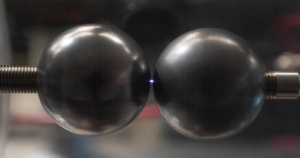Plasma Dynamics of Sparks: Electrostatic and Laser Discharges

Electrostatic discharge (ESD) is an important safety concern for many industrial operations, in particular those that involve risk for fire or explosion. With our work we aim to develop a physical model that can place limits on the current and energy of an ESD pulse that can be used for safety measures.
Our work involves creating a modeling tool for describing how the current pulse in an ESD event evolve. As a circuit, there is a capacitance related to the charged object, a resistance of the ‘victim load’ as well as the spark itself, and some inductance that depends on the geometry of the system. What is non-trivial is the evolution of the effective resistance of the plasma in the spark. The ionization degree, the plasma temperature and the channel size are all changing dynamically. We are developing both detailed and simplified models of this process so that they can be applied to practical and important scenarios. To better understand the physics and plasma chemistry, we are also conducting experiments where we are generating sparks using lasers and using electrostatic discharges. Along with current and voltage measurements, we are developing diagnostics to track the spectral emission, the electron temperature and density.